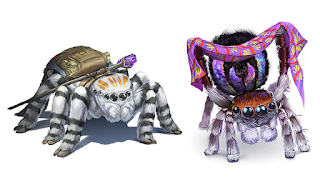 |
| Harmsworth History of the World, 1908 |
The structure is probably best known in modern times for the Porch of the Maidens on the south side of the temple.
The columns supporting the roof of the porch are known architecturally as caryatids, though there are those who seem to be pretty adamant that they be referred to as korai.
 |
| c. 1860 |
Regardless, D&D players probably know of caryatid columns as animated statues originally introduced in the Fiend Folio.
A couple of different miniatures of caryatid columns exist, as shown in the following image.
The first figure is a Pathfinder Caryatid Column that I wrote about before. Next are two Reaper Caryatid Columns (Bones 77378), and the Pillar of Good (Dark Heaven Legends 02815). Metal versions of the Caryatid Columns exist, as does a Bones version of the Pillar of Good.
While I really like the Pillar of Good, the Bones Caryatid Columns left me cold. Particularly the animated statue with angry facial expression, that seems to go against the very nature of stone-faced statues (to my mind).
Maybe they would look better painted up, or if I did some head swaps with more proportional noggins that also better reflect classical or medieval style sculpture.
An interesting related item I have is a second-hand souvenir of the Porch of Maidens that presumably came from Athens.
If the 7.5' height of the caryatids that I read somewhere is accurate, I believe this model is pretty close to 1/72 scale. I plan on removing the lettering from the piece sometime in the future.
I imagine that this souvenir can be found in Greece (where I hope to visit one day), but the only other identifying feature on the piece is the copyright mark on the back.
The final miniature I want to show represents the Varvakeion Athena, a small replica of the Athena Parthenos statue from the Parthenon.
The miniature is from the UHA Collect Club Ancient Civilization series vol. II (UHA味覚糖 コレクト倶楽部II【古代文明編】 No.037). If the model represented the actual statue from the Parthenon, it would be 1/144 scale, but many smaller versions of the original sculpted by Pheidias existed (e.g., from temples in Priene, Pergamon, etc).
It seems likely that some of these reproductions may have been used in temples dedicated to Athena Polias. But unlike the more martial appearance of Athena Parthenos, the statue of Athena Polias in the Erechtheion is said to have been adorned in riches, and held a gold phialê in her right hand.
 |
| Denyse Le Lasseur, 1919 Les déesses armées dans l'art classique grec et leurs origines orientales |
This concludes my final post for 2022. It has been an unusual year, and I don't think I picked up a paint brush or did any model building at all (though I did manage some figure conversions).
I barely made my goal of 12 articles this year, but amazingly enough, I actually exceeded my goal of getting at least 10 subscribers to 1/72 Channel. Hopefully I will be less distracted in 2023 and be able to publish more on both platforms.
Best wishes to all my readers, and have a happy New Year!

















































